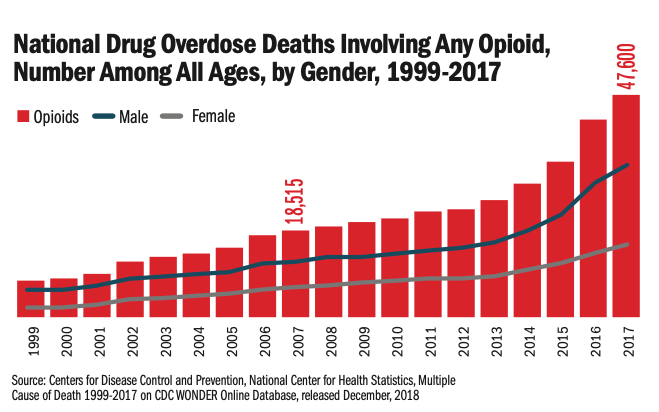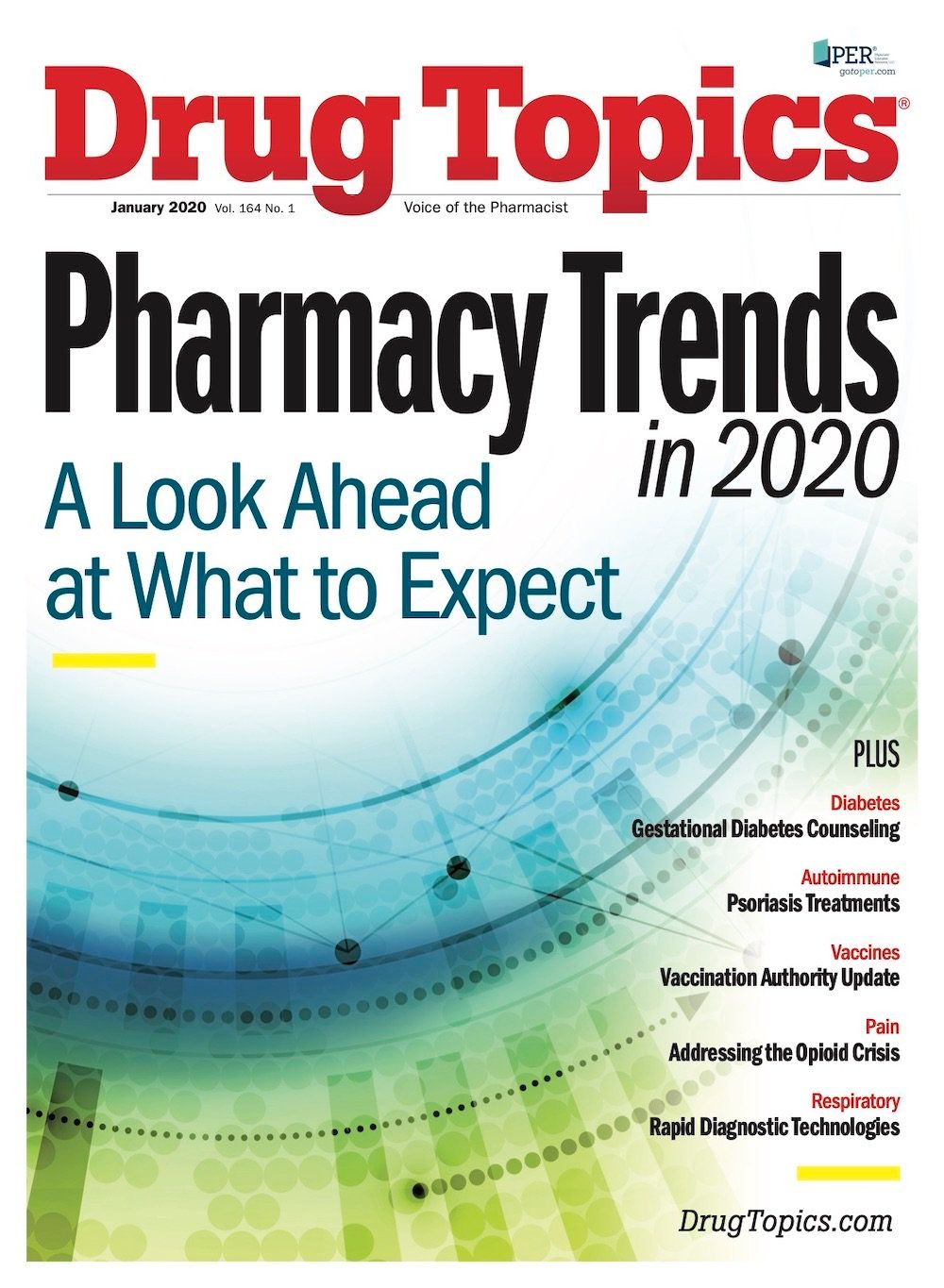Addressing the Opioid Crisis in 2020
The opioid crisis continues to be one of the worst public health crises that the United States has ever seen.

National Drug Overdose Deaths Involving Any Opioid, Number Among All Ages, by Gender, 1999-2017

The opioid crisis continues to be one of the worst public health crises that the United States has ever seen. Opioids- mainly synthetic opioids (other than methadone)-are currently the main driver of drug overdose deaths. According to the CDC, opioids were involved in 47,600 overdose deaths in 2017 or 67.8% of all drug overdose deaths. Approximately 2.1 million Americans live with opioid use disorder.1
Some small signs of improvement have come to light. Opioid prescribing has declined since 2012, and July 2019 data from the CDC demonstrated a 5.1% decline in overdose deaths for the first time since 1990.1 “These numbers are provisional and positive, but improvement is minimal and slow,” Jim Lichauer, PharmD, BCPS, FASHP, program director for Pharmacy Performance Improvement Collaboratives at Vizient, a health care performance improvement company, said. “Increased awareness, appropriate education regarding opioid risks and benefits, and education on non-pharmacologic and non-opioid alternatives have improved prescribing practices.”
The federal government continues to address the crisis with new regulations, said Katharine Van Tassel, JD, MPH, visiting professor of law, Case Western Reserve University School of Law. In the summer of 2019, the FDA issued new draft guid- ance, “Opioid Analgesic Drugs: Considerations for Benefit-Risk Assessment Framework,” which describes the application of the benefit-risk assessment framework that the agency uses in evaluating applications for opioid analgesic drugs.
“Normally, when deciding whether to approve a new drug, the FDA only looks at the risks and benefits to patients who take it as directed, not risks to everyone else,” Van Tassel explained. “Under its new proposal, the FDA will consider whether a new opioid works better than other painkillers-opioid and non-opioid-that are already on the market. Officials will also analyze a new drug’s potential impact on public health.” For example, does it have characteristics that might tempt people to misuse it, such as it being very potent, or easy to crush, dissolve, and inject.
On another front, the Drug Enforcement Administration (DEA), which is responsible for keeping controlled substances from being diverted for abuse and sets a quota for how many opioid pills drug makers are allowed to produce in the United States along with input from the FDA and drug manufacturers, is proposing that appropriate quota reductions be made only after estimating the potential for pills to be sold illegally. Under the proposal, the diversion potential would be based on rates of overdose deaths and abuse, as well as the overall public health impact related to specific controlled substances.
Furthermore, the FDA is using its authority under the Substance Use-Disorder Prevention that Promotes Opioid Recovery and Treatment for Patients and Communities (SUPPORT) Act of 2018 to mandate short-duration packag- ing for outpatient dispensing of certain solid, oral dosage forms of immediate-release opioid analgesics to treat acute pain and require manufacturers to develop technologies such as mailback pouches to dispose of unused opioid medications, Van Tassel reported
The FDA also plans to announce changes to strengthen the Risk Evaluation and Mitigation Strategy for transmucosal immediate-release fentanyl medicines, and issue updated guidance to promote the development of non-opioid drugs to treat pain, Van Tassel added.
Finally, the FDA is focused on securing the legitimate supply chain and doing more to hold distributors responsible. Under the Drug Supply Chain Security Act (DSCSA), manufacturers, re-packagers, wholesale distributors, and dispensers-which are all mainly pharmacies-are all required to have systems and processes in place to quarantine and investigate suspect and illegitimate medications, Van Tassel said.
“The FDA plans to ensure that entities responsible for maintaining the supply chain take measurable steps under the law to appropriately track and trace opioid medications as these products move through the supply chain, and to respond to incidents involving illegitimate products to protect the public health,” Van Tassel said.
States also issue their own laws regarding drugs, which generally address limiting initial prescription quantities, requiring prescribers to query the state’s prescription drug monitoring program prior to prescribing, requiring provider education or training as well as patient education, and requiring co-prescribing of naloxone, the opioid reversal agent, Lichauer said.
The Pharmacist’s Role
Regarding states’ rules, Lichauer said that limiting initial prescription quantities will reduce the potential for leftover pills, which can fall into the wrong hands and be misused, and can lower the risk of long-term opioid dependency. A CDC study correlated higher initial prescription quantities with a greater risk of continued use at 1 and 3 years.2 The same study also demonstrated an increase in continued use at 1 and 3 years for patients who received a third prescription refill of their initial opioid pain medication.
Upon dispensing in most states, pharmacists are required to query a patient’s history in the prescription drug monitoring program (PDMP) database. “Pharmacists need to know their state regulations on prescription quantities and refills as well as requirements for patient education,” Lichauer said
Pharmacists should be sure that their entire staff is registered for their state’s PDMP and that they check it every time a controlled substance medication is dispensed, said Andrew Smith, PharmD, BCPS, BCCCP, assistant professor and PGY-2 emergency medicine residency program director, Touro College of Pharmacy. Furthermore, since pharmacies are required to send data to the state for this reporting program, finding ways to streamline the reporting process will help decrease their perceived workload burden.
Pharmacists need to review their state laws and figure out what their roles can be to help their communities. “If naloxone is available as a standing order under state law, pharmacies should be sure to have an adequate supply and they should train their pharmacists and interns to counsel patients and be candid about the risks of even a short course of opioids for patients,” Smith said. Furthermore, pharmacies should become more familiar with medication-assisted treatment (MAT) as more emergency physicians begin initiating treatment in the emergency department as a bridge to long-term treatment with an addiction medicine specialist. MAT will grow over time as more patients get the help they need.
Van Tassel said that pharmacists are stepping up to address the opioid crisis by playing an active role in stewardship programs to prevent opioid misuse. These programs are designed to promote appropriate use of opioids, improve patient outcomes, and reduce the misuse of opioids.
Pharmacists are also participating in opioid stewardship programs through clinical education and guideline generation, and by using PDMP database searches to track prescribing practices and patient behavior that can drive opioid abuse, Van Tassel said. Pharmacists are monitoring prescribing practices to identify outliers among providers, to assess the appropriate use of clinical decision support, to impose restrictions on specific opioids and doses, and to provide daily feedback to prescribers.
Most hospitals assign pharmacists to play pivotal roles in drug therapy management. Pharmacists do so by assessing therapeutic drug levels, patient outcomes, laboratory results, and adverse drug events to track potential opioid abuse, Van Tassel concluded.
References:
- Ahmad FB, Escobedo LA, Rossen LM, et al. Provisional drug overdose death counts. National Center for Health Statistics. 2019. https://www.cdc.gov/nchs/nvss/vsrr/drug-overdose-data.htm?mod=article_inline.
- Shah A, Hayes CJ, Martin BC. Characteristics of initial prescription episodes and likelihood of long-term opioid use – United States, 2006-2015. Morbidity and Mortality Weekly Report. March 17, 2017. Doi: http://dx.doi.org/10.15585/mmwr.mm6610a1external icon.
